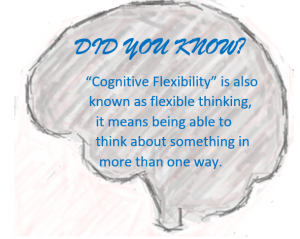Welcome to Module 2: Understanding Executive Function
In this module, we will consider more fully the higher level skills completed by the brains cortex. Collectively these skills are known as Executive Function.
What is Executive Function?
Executive Function is a set of mental skills that act as a command centre for other skills within the brain. If you think of the brain as being an orchestra, where all of your separate skills and knowledge are the individual instruments, Executive Function is like the conductor. Each instrument might play skilfully and accurately alone, but in order to make music together they require the conductor to guide them, for example, when to begin, take over, or stop. In the same way, Executive Function helps people use their individual skills to plan their actions, manage their time, control their emotions, solve problems and complete tasks. All are skills in their own right, but they need to work in tandem in order for a task to be successfully completed.

Our orchestra of Executive function is generally understood to include the following individual skills:
- Planning and organisation
- Flexible thinking
- Monitoring performance
- Multi-tasking
- Solving unusual problems
- Self-awareness
- Learning rules
- Social behaviour
- Making decisions
- Motivation
- Initiating appropriate behaviour
- Inhibiting inappropriate behaviour
- Controlling emotions
- Concentrating and taking in information
The 5 main areas
Since so many skills are involved, these abilities are categorised into five central areas.
Look at the diagram below and click on each heading to find out more:
Everyday Executive Function
Now let’s consider the elements of an everyday task, for example, a situation where someone asks you to go upstairs and bring down an item from a particular room, this requires you to complete the steps outlined below.
Match each step to the skills in the list to see how Executive Function help us complete day to day tasks.

Developing Executive Function
Executive function skills develop over time and in line with our varying rates of development. Below are some examples of how we might use these skills in ever more complex ways over the course of typical development.
This is because the part of the brain responsible for Executive Function, the frontal lobe, continues to develop until we are in our mid-late twenties.

This doesn’t mean that we can’t improve our Executive Function beyond our mid-twenties, the good news is that these functions can be improved at any point over our lives. However, it does become more difficult to develop these skills later in life, and improvements may be comparatively small.
Testing your Executive Function
If you would like to test out how well your own Executive Function is working, try out this online demonstration, provided with thanks to the EKR Agency.
In this demonstration, you will be asked to follow two simple rules, but to follow these rules you will need to be able to switch between acting or not acting (inhibition). You will also need to shift your focus between both sides of the screen and keep the rules in mind throughout the task. It might appear simple, but your executive function will have to work hard to manage all these elements. The test will continue indefinitely so you may wish to pick a number and see your percentage success at the end of this time. 70-100% is likely to mean your Executive Function is working well. You may also wish to reset the test and compare how well you do a second time, are you getting better as you practise?
Let’s see how well your Executive Function has been allowing you to learn so far? Complete this drag and drop exercise to complete this module:

Well done for finishing Module 2. When you are ready, please proceed to Module 3: Difficulties with Executive Function to learn about what problems in developing executive function might look like.
